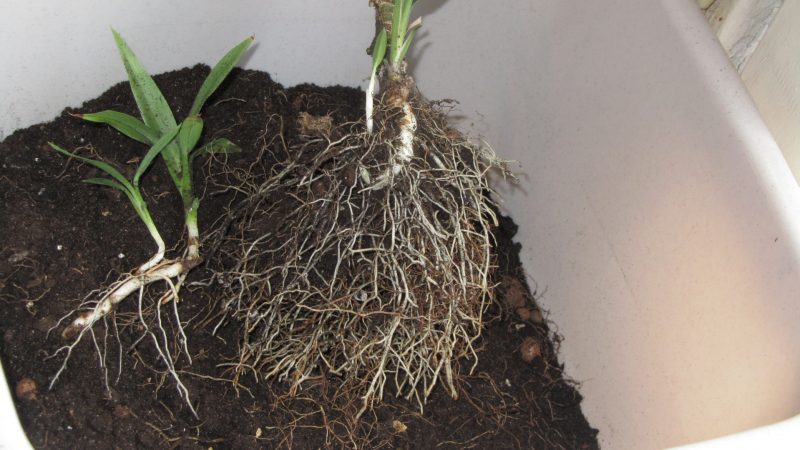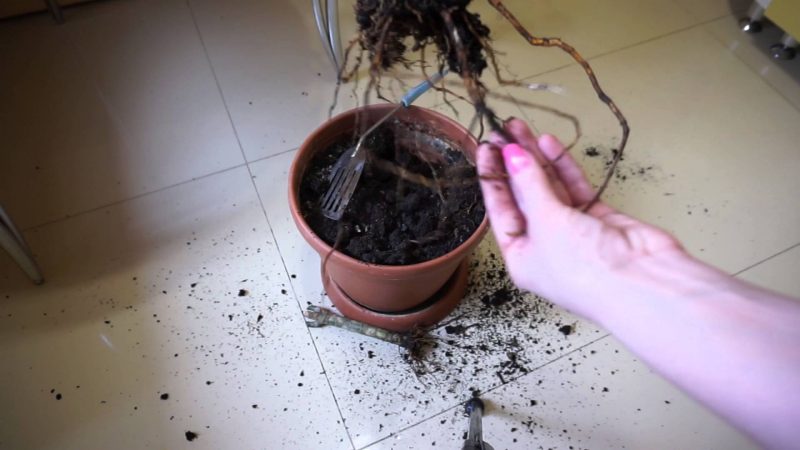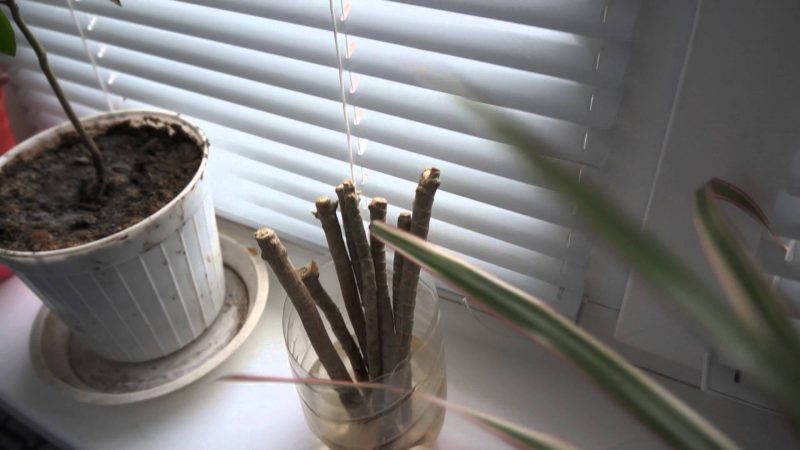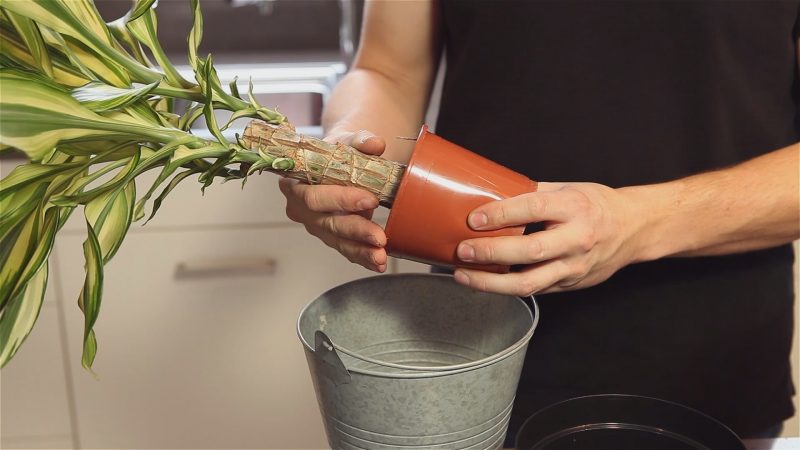Information on how to transplant a dracaena, surely sooner or later every lover of this plant will need it. Timely care of the flower will preserve its health and attractive appearance.
Material Content:
When a dracaena transplant is needed

Replacing the pot may need a flower in several cases:
- close to him;
- the plant is sick;
- pests appeared in the soil;
- A newly purchased item is in unsuitable soil.
Dracaena needs an average transplant every three years. The procedure is carried out when roots appear in the drainage hole. If they go outside, it means that the root system has completely occupied the space of the pot. In such a situation, the roots do not have enough room for growth, and the flower itself does not receive a sufficient amount of useful elements.
It happens that the roots do not go into the pan, but at the same time the dracaena grows poorly, loses a lot of leaves, and new ones do not appear. Such signs can also indicate a lack of space for plant development.
In winter, all the vital processes of dracaena are slowed down, and in spring, growth accelerates, it intensively builds up roots and new leaves. That is why the best time for a planned replacement of the pot is the end of March or April.
Sometimes an extraordinary transplant is performed. It sometimes needs to be done if the flower withers leaves, rot appears at the base of the stem or when the soil acquires a specific musty smell. Such signs may indicate rotting of the roots, poor quality of the substrate, overflow of dracaena. Then the flower is taken out of the pot and carefully examined the roots and soil, if necessary, transplanted.In the presence of pests, the transplant is carried out several days after treatment with suitable insecticides.
Do I need to transplant the plant after purchase
Changing the pot of dracaena immediately after the acquisition is not necessary. If the flower feels good, and the soil in the flowerpot is not satisfactory, then it is better to give the plant the opportunity to adapt to new living conditions.

It is better to transplant the next spring after purchase. This must be done even if the size of the flowerpot is optimal and the dracaena has enough space for growth and development. Flower shops sell plants brought from Holland. For them, transporting soil is used as a substrate: a light peat mixture with a small amount of useful substances. It is undesirable to grow dracaena in such soil for a long time.
Preparation of substrate and pot
You can buy ready-mixed soil for dracaena or make the soil yourself. When buying, choose a substrate for palm trees or land for large non-flowering houseplants. It is better to purchase soil in specialized flower shops and choose good quality goods. To prepare the soil with their own hands, they take garden soil, peat and compost in a ratio of 3: 1: 1. You can add a little sand, vermiculite or chopped charcoal. The proportions vary depending on the properties of the garden land.

The size of the pot is chosen in accordance with the dimensions of the plant, and there must be holes in the bottom. When it comes time to transplant the dracaena into another pot, each time they take a flowerpot of a slightly larger diameter.
You need to focus on the size of the root system: in the new pot, the gap between the walls of the container and the earthen lump with roots should remain about three centimeters.
Do not transplant the plant into containers that are too large. The soil will begin to sour, as insufficiently branched roots do not have time to absorb nutrients and water.
Before use, the flowerpot is cleaned of dirt if necessary. Then wash with warm water and laundry soap. After this, pour boiling water over. It is especially important to carry out such a procedure for clay pots, in the pores of which dirt and pathogens of various diseases accumulate.
Step-by-step instructions on how to transplant a dracaena
The plant transplant process is simple. The main thing is to do everything slowly, carefully, so as not to injure the ground part and tender roots.

Pre-prepare the standing water and sharp scissors (secateurs). The tool is disinfected in advance. You can bake the tip over the fire or grease with an alcohol solution.
How to transplant dracaena:
- A drainage layer about 3 cm high is placed at the bottom of the pot. Expanded clay, small clay shards, and pebbles can be used.
- Carefully remove the plant from the flowerpot.
- In the upper part of the plant (above the roots) the earth is completely removed, the soil between the roots is partially left.
- Inspect the root system. Dry, rotten and damaged roots are removed. If the subterranean part is too large compared to the terrestrial size, a few poorly located healthy roots are cut off. Slices sprinkled with crushed ash and allow them to dry slightly.
- A little soil is placed on the drainage layer and slightly compacted.
- In the center of the flowerpot, they place a dracaena, spread their roots evenly in capacity. The planting depth of the flower is left the same, the position of the root neck should not change in a new container.
- They fill the pot with earth. From time to time they shake the pot or tap it on the floor to fill the voids between the roots with soil.
- They compact the soil, slightly pressing on it.
- Water the flower abundantly, then the leaves are sprayed. The substrate will settle, so some more soil is added.
If necessary, use a damp sponge to remove dirt on the flower and pot. 5 to 10 minutes after transplantation, excess moisture is drained from the pallet.
Read also:dieffenbachia
For large adult dracaena, the transshipment method is used. In the prepared pot, drainage and some earth are placed.The plant is removed from the pot, shaken and removed a couple of centimeters of the upper layer of soil. Then transferred to a new container, add the right amount of substrate and watered.
Aftercare
Transplanted dracaena needs special care. It can not be placed in the sun for several weeks. Water the first couple of weeks every 3 to 4 days, then less often. After the procedure, the flower is kept at a moderate temperature of about +20 degrees for a while.
Common mistakes
Oversights during dracaena transplantation at home can adversely affect the health and appearance of the plant.

What pay special attention when carrying out work:
- optimal pot size;
- good quality soil;
- several drainage holes in the bottom and a drainage layer in the bottom of the pot.
Sometimes the procedure is not carried out carefully and carefully enough. This increases the risk of damage to the roots, which can rot over time. Dracaena transplantation is an important part of flower care. Everyone can properly organize the process, given all the important points.












